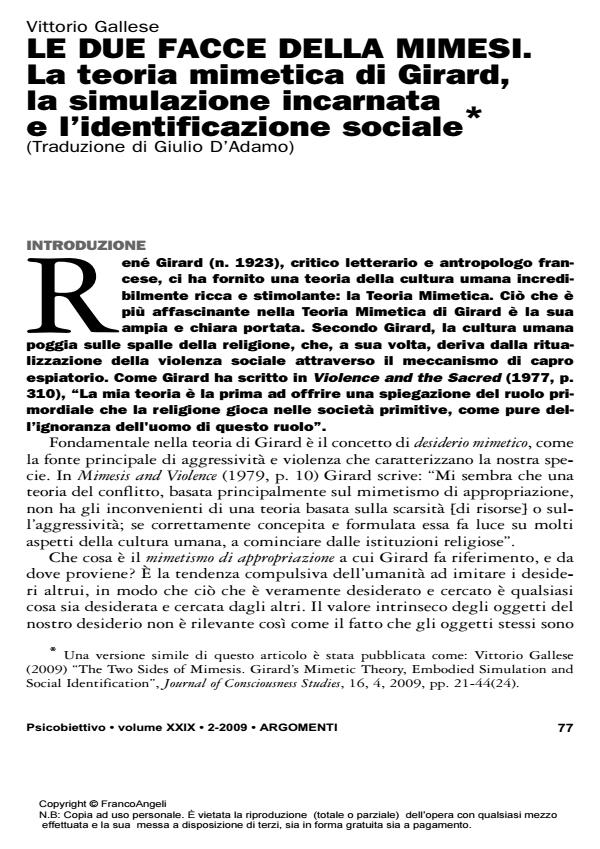Le due facce della mimesi. La teoria mimetica di Girard, la simulazione incarnata e l'identificazione sociale
Journal title PSICOBIETTIVO
Author/s Vittorio Gallese
Publishing Year 2010 Issue 2009/2
Language Italian Pages 24 P. 77-100 File size 346 KB
DOI 10.3280/PSOB2009-002005
DOI is like a bar code for intellectual property: to have more infomation
click here
Below, you can see the article first page
If you want to buy this article in PDF format, you can do it, following the instructions to buy download credits

FrancoAngeli is member of Publishers International Linking Association, Inc (PILA), a not-for-profit association which run the CrossRef service enabling links to and from online scholarly content.
The two sides of mimesis. Girardi’s mimethic theory, embodied simulation and social identification - Crucial in Girard’s Mimetic Theory is the notion of mimetic desire, viewed as appropriative mimicry, the main source of aggressiveness and violence characterizing our species. The intrinsic value of the objects of our desire is not as relevant as the fact that the very same objects are the targets of others’ desire. One could in principle object against such apparently negative and one-sided view of mankind, in general, and of mimesis, in particular. However, such argument would misrepresent Girard’s thought. Girard himself acknowledged that mimetic desire is also good in itself, because is at the basis of love, and even more importantly because it’s the opening out of oneself. Starting from the notion of desire as openness to others I will discuss from a neuroscientific perspective the implications for social cognition of mimesis against the background of Girard’s Mimetic Theory, an ideal starting framework to foster a multidisciplinary approach to the study of human intersubjectivity. It will be posited that a different, not mutually exclusive, account of mimesis leads to social identification henceforth to sociality. Mimesis is neither good or bad, but has the potentials to lead not only to mimetic violence but also to the most creative aspects of human cognition. Results of empirical research in neuroscience and developmental psychology show that such account of mimesis finds solid supporting evidence. It will be concluded that a thorough and biologically plausible account of human intersubjectivity requires the integration of both sides of mimesis.
Keywords: René Girard; Mimetic Theory; Embodied Simulation; Mirror Neurons.
- Epilessia come segno di selezione vittimaria. Girard e Dostoevskij Valentina Vignotto, in ENTHYMEMA /2024 pp.34
DOI: 10.54103/2037-2426/20036 - Trame di luce Uso di immagini d'arte in terapia individuale e di coppia ad orientamento sistemico-relazionale Conny Leporatti, in PSICOBIETTIVO 1/2016 pp.137
DOI: 10.3280/PSOB2016-001010 - Inclusion, Communication, and Social Engagement Nadia Carlomagno, Maria Vittoria Battaglia, Valeria Vadalà, pp.214 (ISBN:978-3-032-03020-7)
Vittorio Gallese, Le due facce della mimesi. La teoria mimetica di Girard, la simulazione incarnata e l'identificazione sociale in "PSICOBIETTIVO" 2/2009, pp 77-100, DOI: 10.3280/PSOB2009-002005